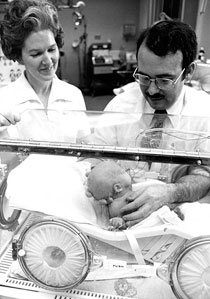Reducing Infant Mortality
By Tara Hulen
 |
More than 50,000 babies have been delivered at UAB Hospital over the decades. Photo courtesy of UAB Archives.
|
A baby is more likely to die in the first year than in all other years of childhood combined. Sadly, it is even more likely to happen in Alabama, which consistently ranks among the top 10 states in infant mortality. If these statistics have a silver lining, it is that the mortality rate has decreased by about 50 percent in the last 30 years, both nationally and in Alabama.
A key way to reduce those numbers even further is to ensure that pregnant mothers and at-risk infants receive specialized care very early, says Wally Carlo, M.D., director of the Division of Neonatology in the School of Medicine. And, he adds, the SOM and UAB have long played a crucial role in providing that care to the region.
Reducing the Risk
In the 1960s and ‘70s, George Cassady, M.D., led the fight against Alabama’s infant mortality. An SOM pediatrics professor and director of UAB’s high-risk nursery, he developed one of the country’s most advanced neonatal programs, ensuring that it utilized the latest procedures and technology. Cassady also shared that lifesaving knowledge with hospitals around Alabama, encouraging them to create their own intensive-care nurseries. A premature baby born in a hospital without a neonatal intensive-care unit has about twice the mortality risk of a baby born in a hospital with one, Carlo explains.
For the toughest cases, UAB has served as the regional and state referral center for decades. Its neonatologists are in the hospital 24 hours a day, and it offers Alabama’s only Level IIIC Regional Neonatal Intensive Care Unit (RNICU)—the highest level attainable. UAB also is one of 14 centers in the National Institutes of Health Maternal-Fetal Medicine Units Network, one of only 16 NIH Neonatal Research Network Centers, and one of only seven NIH Global Network for Women’s and Children’s Health Research; it is the only university participating in all three perinatal networks.
Carlo explains that it’s not often feasible for small or rural hospitals to have the latest equipment and treatments, much less neonatal and maternal-fetal specialists. Because so many high-risk births are unexpected, UAB trains physicians and nurses from other hospitals on the best ways to stabilize infants before transport.
A Common Problem
UAB’s program has higher survival rates than the national average and most NICUs in the country, Carlo notes, but the state’s infant-mortality rate is about a third higher than the national average. In 2007, that rate was 10 per 1,000 births.
As in other states, the leading causes of infant death in Alabama are prematurity or low birth weight, which is less than five pounds. Though poverty and lack of prenatal care are major contributing factors, infant mortality impacts all types of families, Carlo says. “Most women whose pregnancies become high-risk did nothing wrong; it can happen to anyone. About 15 percent of pregnancies are high-risk.” And predicting those pregnancies is difficult; approximately 20 percent of women do not know their pregnancy is high-risk until labor, when the baby is born early or underweight.
One crucial problem for premature babies is underdeveloped lungs, and UAB “has been a pioneer in developing techniques to reduce chronic lung disease,” Carlo says. Treatments include antenatal steroids, which mature infant lungs, given to mothers in premature labor. “Another improvement is surfactant, a substance the lungs lack if the babies are born prematurely. We administer surfactant directly into the lungs, and the lungs mature right away.” The treatments not only help babies survive, but they also can prevent lifelong lung problems.
 |
The new Women & Infants Center will open next door to UAB Hospital in spring 2010. |
The neonatology program begins a new chapter next year inside the new 400,000-square-foot Women & Infants Center, housing an expanded RNICU/Continuing Care Nursery (CCN). It will be one of the first hospitals in the Southeast to offer private rooms in the RNICU and CCN, where mothers and infants can stay together in the same room.
While Alabama’s infant mortality rates are frustrating, “we’re seeing a lot of improvement,” Carlo says. “If the babies make it to our NICU, they have great outcomes. They are very sick when they come in, but the overwhelming majority of them survive.”

